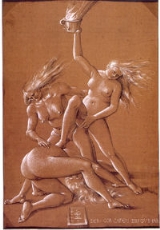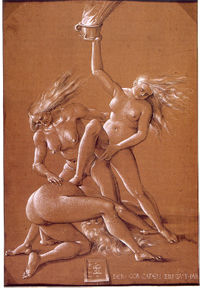
Skyclad
Encyclopedia

Wicca
Wicca , is a modern Pagan religious movement. Developing in England in the first half of the 20th century, Wicca was popularised in the 1950s and early 1960s by a Wiccan High Priest named Gerald Gardner, who at the time called it the "witch cult" and "witchcraft," and its adherents "the Wica."...
and Paganism/Neo-paganism, the term skyclad is used to refer to ritual nudity
Nudity
Nudity is the state of wearing no clothing. The wearing of clothing is exclusively a human characteristic. The amount of clothing worn depends on functional considerations and social considerations...
. Some Wiccan groups, or Traditions, perform some or all of their rituals skyclad. Whilst nudity and the practice of witchcraft
Witchcraft
Witchcraft, in historical, anthropological, religious, and mythological contexts, is the alleged use of supernatural or magical powers. A witch is a practitioner of witchcraft...
have long been associated in the visual arts, this contemporary ritual nudity is typically attributed to either the influence of Gerald Gardner
Gerald Gardner
Gerald Brousseau Gardner , who sometimes used the craft name Scire, was an influential English Wiccan, as well as an amateur anthropologist and archaeologist, writer, weaponry expert and occultist. He was instrumental in bringing the Neopagan religion of Wicca to public attention in Britain and...
or to a passage from Aradia, or the Gospel of the Witches
Aradia, or the Gospel of the Witches
Aradia, or the Gospel of the Witches is a book composed by the American folklorist Charles Leland that was published in 1899. It contains what he believed was the religious text of a group of pagan witches in Tuscany, Italy that documented their beliefs and rituals, although various historians and...
, and as such is mainly attributed to the Gardenerian and Aradian covens.
Gardner's Witchcraft Today
Witchcraft Today
In the book Gardner also repeats the claim, which had originated with Matilda Joslyn Gage, that 9 million victims were killed in the European witch-hunts." Current scholarly estimates of the number of people executed for witchcraft during this time period vary between about 40,000 and 100,000.The...
was published in 1954. The book claimed to report on the contemporary practice of Pagan religious witchcraft in England, which had supposedly survived as an underground religion for centuries. Ritual nudity was included as a regular part of Wiccan practice, and remains associated with Gardnerian Wicca
Gardnerian Wicca
Gardnerian Wicca, or Gardnerian Witchcraft, is a mystery cult tradition or denomination in the neopagan religion of Wicca, whose members can trace initiatory descent from Gerald Gardner. The tradition is itself named after Gardner , a British civil servant and scholar of magic...
. The "Charge of the Goddess
Charge of the Goddess
The Charge of the Goddess is a traditional inspirational text sometimes used in the neopagan religion of Wicca. Several versions exist, though they all have the same basic premise, that of a set of instructions given by a Great Goddess to her worshippers...
", a part of Gardnerian ritual liturgy, instructs Wiccans to practice ritual in the nude. Gardner spent several years in India, and may have picked up the concept from the Digambara
Digambara
Digambara "sky-clad" is one of the two main sects of Jainism. "Sky-clad" has many different meaning and associations throughout Indian religions. Many representations of deities within these traditions are depicted as sky-clad, e.g. Samantabhadra/Samantabhadrī in Yab-Yum...
Jains
Jainism
Jainism is an Indian religion that prescribes a path of non-violence towards all living beings. Its philosophy and practice emphasize the necessity of self-effort to move the soul towards divine consciousness and liberation. Any soul that has conquered its own inner enemies and achieved the state...
, a religious sect in which the monks may not wear clothing.
The origins of this instruction have been traced to Charles Godfrey Leland
Charles Godfrey Leland
Charles Godfrey Leland was an American humorist and folklorist, born in Philadelphia, Pennsylvania. He was educated at Princeton University and in Europe....
's 1899 book, Aradia, or the Gospel of the Witches
Aradia, or the Gospel of the Witches
Aradia, or the Gospel of the Witches is a book composed by the American folklorist Charles Leland that was published in 1899. It contains what he believed was the religious text of a group of pagan witches in Tuscany, Italy that documented their beliefs and rituals, although various historians and...
. The following speech by Aradia
Aradia (goddess)
Aradia is one of the principal figures in the American folklorist Charles Leland’s 1899 work Aradia, or the Gospel of the Witches, which he believed to be a genuine religious text used by a group of pagan witches in Tuscany, a claim that has subsequently been disputed by other folklorists and...
appears at the end of the book's first chapter;
And as the sign that ye are truly free,
Ye shall be naked in your rites, both men
And women also: this shall last until
The last of your oppressors shall be dead;
Dr. Leo Ruickbie
Leo Ruickbie
Leo Ruickbie is an historian and sociologist of magic, witchcraft and Wicca. He is the author of several books, beginning with Witchcraft Out of the Shadows, a 2004 publication outlining the history of witchcraft from ancient Greece until the modern day. Ruickbie was born in Scotland and took a...
also notes that the traditional and artistic representation of witches cannot be overlooked as a source for nudity in Gardner's system, citing artists such as Albrecht Dürer
Albrecht Dürer
Albrecht Dürer was a German painter, printmaker, engraver, mathematician, and theorist from Nuremberg. His prints established his reputation across Europe when he was still in his twenties, and he has been conventionally regarded as the greatest artist of the Northern Renaissance ever since...
and Salvator Rosa
Salvator Rosa
Salvator Rosa was an Italian Baroque painter, poet and printmaker, active in Naples, Rome and Florence. As a painter, he is best known as an "unorthodox and extravagant" and a "perpetual rebel" proto-Romantic.-Early life:...
.
Doreen Valiente
Doreen Valiente
Doreen Edith Dominy Valiente , who also went under the craft name Ameth, was an influential English Wiccan who was involved in a number of different early traditions, including Gardnerianism, Cochrane's Craft and the Coven of Atho...
, one of Gardner's priestesses, recalls Gardner's surprise at Valiente's recognition of material from Aradia in the original version of the "Charge" that she was given. Valiente later rewrote the "Charge", preserving the lines from Aradia. Valiente's version was then widely circulated and reprinted.
Accepting Aradia as the source of skyclad practice, Robert Chartowich points to the 1998 Pazzaglini translation of these lines, which read "Men and Women / You will all be naked, until / Yet he shall be dead, the last / Of your oppressors is dead." Chartowich argues that the ritual nudity of Wicca was based upon Leland's mistranslation of these lines by incorporating the clause "in your rites".
Ritual nudity is not exclusive to traditional Wicca. Amongst those groups that do, only some rituals may involve ritual nudity. The Arician tradition
Stregheria
Stregheria is a form of ethnic Italian form of Wicca originating in the United States, popularized by Raven Grimassi since the 1980s. Stregheria is sometimes referred to as La Vecchia Religione The word stregheria is an archaic Italian word for "witchcraft", the modern Italian word being...
, as an example, practices skyclad for six months of the year, and performs their ceremonies in ritual robes for the other half of the year. Within, and especially outside of, specific areas of Wicca and Pagan, reasons other than tradition may be given to explain a preference for skyclad worship. Starhawk
Starhawk
Starhawk is an American writer and activist. She is well known as a theorist of Paganism, and is one of the foremost popular voices of ecofeminism. She is a columnist for Beliefnet.com and On Faith, the Newsweek/Washington Post online forum on religion...
states in Spiral Dance, "nudity establishes a closeness and honesty among coveners and 'is a sign that a witches loyalty is to the truth before any ideology or any comforting illusions.'"
The term "skyclad" is most likely derived from Indian religions, where the term Digambara literally means "sky-clothed". England had close links with India at the time when Wicca first became public in England, so this usage could well have been familiar to English speakers with a knowledge of Far Eastern religions. In particular, Gerald Gardner, who first popularized Wicca in England, was a noted folklorist with an interest in Far Eastern culture who spent much of his adult life in Ceylon and Burma, so it seems very plausible that he could have been familiar with this Hindu term.

